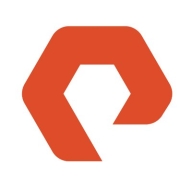


SolidFire and Pavilion HyperParallel Flash Array are two storage solutions competing in the market. SolidFire is generally preferred for its cost-effectiveness and support, while Pavilion HyperParallel Flash Array stands out for its advanced features, making it worth the price for many users.
Features: SolidFire users appreciate its scalability, automation, and consistent performance. Pavilion HyperParallel Flash Array receives praise for high throughput, low latency, and versatility across workloads.
Room for Improvement: SolidFire users frequently mention the need for improvements in system stability and feature expansion. Pavilion HyperParallel Flash Array users point out the complexity of management and the need for better documentation.
Ease of Deployment and Customer Service: SolidFire is known for its relatively straightforward deployment process and responsive customer service. Pavilion HyperParallel Flash Array, while delivering high performance once deployed, is often reported as being more complex to set up, with mixed reviews on the support quality.
Pricing and ROI: SolidFire is favored for its competitive setup costs and solid return on investment. Pavilion HyperParallel Flash Array, although more expensive, is valued for delivering exceptional performance metrics, which many users find justifies the higher cost.


Pure Storage FlashArray//X is the world’s first enterprise-class, all-NVMe flash storage array. It represents a new class of storage – shared accelerated storage, which is a term coined by Gartner – that delivers major breakthroughs in performance, simplicity, and consolidation.
Pavilion HyperParallel Data Platform
The Pavilion HyperParallel Data Platform™ dramatically accelerates what organizations achieve by delivering universally unmatched storage performance, in an incredibly compact solution while reducing data center costs and complexity. Unrivaled flexibility for multiple data types and protocols, along with broad ecosystem integration, ensure that every customer has choice and control.
What is the Pavilion HyperParallel Data Platform
The Pavilion HyperParallel Data Platform is comprised of the Pavilion HyperParallel Flash Array™ and Pavilion HyperOS™. The Pavilion HyperParallel Flash Array leverages a unique, switch-based architecture to create a multi-controller solution that delivers an unmatched combination of high performance, ultra-low latency, and storage density. Pavilion HyperOS is a powerful, purpose-built storage operating system designed to unlock the power of the multi-controller Pavilion HyperParallel Flash Array, which delivers scalability and flexibility that no other solution can offer.
Pavilion HyperParallel Data Platform Data Sheet
Download the Pavilion HyperParallel Data Platform data sheet. Updated: December 2020
SolidFire delivers all five core elements needed to deliver newfound storage agility to your next generation data center and beyond. With SolidFire you can deploy new applications and capabilities faster, provide more agile and scalable infrastructure, increase application performance and predictability, enable automation and end-user self-service and raise operational efficiency and reduce cost.
We monitor all All-Flash Storage reviews to prevent fraudulent reviews and keep review quality high. We do not post reviews by company employees or direct competitors. We validate each review for authenticity via cross-reference with LinkedIn, and personal follow-up with the reviewer when necessary.